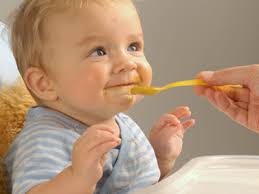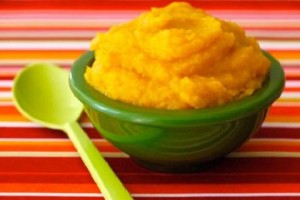Feeding Your Baby : 8 Eating Milestones
There are many baby development milestones when it comes to eating solid foods. Here are some of the big ones.
 Baby Milestone 1: When They Can Start Solids
Baby Milestone 1: When They Can Start Solids
Most pediatricians, and the American Academy of Pediatrics, recommend introducing solid foods to babies at between 4 and 6 months of age. That’s when they start to lose the “tongue-thrust reflex” or extrusion reflex, which is important for sucking the breast or bottle but interferes with feeding.
If your baby is around this age, can sit up well with support, and shows interest in the foods he sees you eating, it’s probably a good time to make your first forays into feeding baby solid food. If your baby is exclusively breastfed, it is recommended that you wait until 6 months of age to start solids.
Baby Milestone 2: When They’re Ready to Move From Puree to Chunks
“Chunking up” babies’ food is a process — obviously, they shouldn’t go straight from rice cereal to raisin bran. But after the first few weeks of adjusting to eating rather than just drinking his food, your baby should be ready to handle a little more texture in solid foods.
Introduce new textures slowly. Good starters are mashed bananas or mashed avocados. You can also use the “staged” store-bought baby foods — going from the smooth puree of stage 1 to the slightly thicker stage 2 and then the chunkier stage 3 by around 9 months of age. (Babies don’t necessarily have to have a lot of teeth to handle more texture in their foods — they can often gum soft foods very well!)
Baby Milestone 3: When They Can Sit in a High Chair
If babies are ready to eat solid foods — in other words, they can sit upright with support and hold up their head and neck — they’re ready to sit in a high chair. This is usually around 4 months of age. The chair straps and the tray offer support, and can help him stay in position. Always buckle baby in to his chair, even if he is unable to get out with the tray in place. As he gets older and becomes more active, he may be able to squirm out. Plus, it is good to get in the habit of buckling him in as soon as you start using one.
Baby Milestone 4: When They Can Manage Finger Foods
Babies between 7 and 11 months old usually tell you they’re ready to eat more grown up foods by trying to grab them from you. Almost any food that is healthy and nutritious and has a soft texture makes a good finger food, if it’s cut small enough: diced pasta; small pieces of well-cooked vegetables such as carrots, peas, or zucchini; and pea-sized bites of chicken or soft meat. Small, unsweetened round cereals and cereal puffs are also a good choice.
At first babies “rake” food into their hand, but soon they develop the “pincer grasp” that allows them to pick up small objects between thumb and forefinger. At that point, your baby can become a pro at self-feeding!
Baby Milestone 5: When They Start Using Spoons
Almost as soon as babies adjust to being fed with a spoon, they’re interested in it and want to grab that thing and shove it into their mouths themselves. That doesn’t mean they’re very good at it, of course!
Most babies don’t learn to use a spoon effectively until after their first birthday, but that doesn’t mean you can’t let a younger baby who’s interested give it a whirl for practice. Try giving him a soft-tipped spoon to hold while you feed him with another. He can get used to holding the spoon himself and will also be distracted from grabbing yours.
When you think he’s ready to actually navigate the spoon into his mouth, try thicker, stickier foods like yogurt, mashed potatoes, or cottage cheese. Another tip: Put some cream cheese on the spoon and then a few pieces of o-shaped cereal on top. The cream cheese won’t fly everywhere, and baby can get the experience of getting cereal into his mouth.
Expect a mess! Use a plastic or other waterproof bib, and put a mat under the high chair to make cleanup easier.
Baby Milestone 6: When They Can Try Highly Allergenic Foods
Some pediatricians still recommend waiting until children are 1-years-old or older before offering them certain foods that are highly allergenic, like eggs or fish. But current research doesn’t demonstrate any benefit to waiting past a certain age to introduce these foods unless you have a significant family history of food allergies or other reasons to believe your baby may be predisposed to them.
There is no evidence that introducing highly allergenic foods to children under the age of 1 makes them any more likely to be allergic to them, and the American Academy of Pediatrics now says it’s fine to give these foods before baby’s first birthday. Many pediatricians are still very cautious about shellfish and peanuts, however, because allergic reactions to these foods can be particularly dangerous.
 Baby Milestone 7: When They Can Drink Water
Baby Milestone 7: When They Can Drink Water
Babies don’t need water during their first 6 months of life. They get all the water they need from breast milk or baby formula. Babies under 6 months of age should not be given any water at all because it’s easy to fill up their tiny stomachs — and they should be filling up on the nutrients they need to grow. Once they start eating mostly solid foods, around 9 months of age, they can start water with meals using a sippy cup.
If your older baby shows an interest in water that you’re drinking, there’s no harm in letting him have a few sips. Just don’t let it replace the nutritious breast milk or formula he should be getting.
Baby Milestone 8: When They Can Completely Feed Themselves
Mastering eating with utensils is a long process. Most babies do not become really skilled at it until well over a year. Encourage your child to practice, and again, be prepared for a little mess. (How else will you get the “oatmeal in the hair” pictures that will embarrass him years later?)
*excerpt from www.webmd.com








